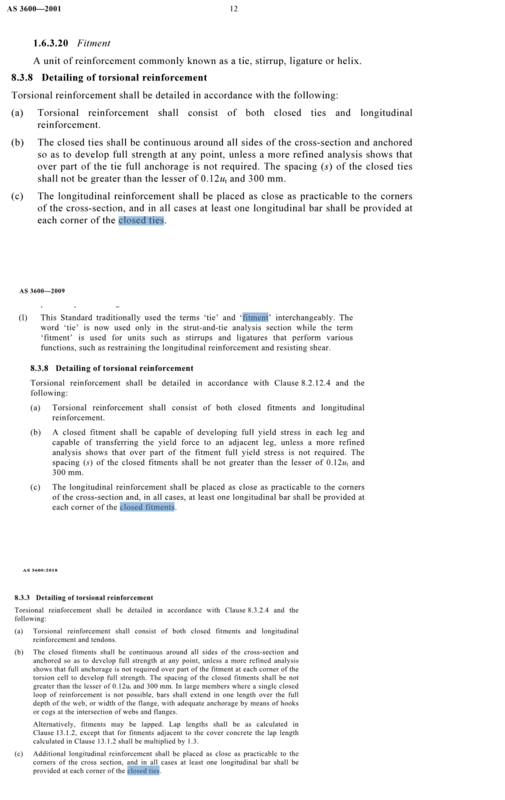The 2018 code now states that ANY wall 65MPa or great must comply with Section 14.5.4 regardless (refer 11.7.4 & 14.6.3). 14.5.4 states that any (wall) with N*> 0.65x0.3f'c must have each longitudinal bar restrained by a "closed fitment".
Firstly, what denotes a closed fitment?
I have always thought that 'closed' referred to a fully enclosed shape detail with typically two 135 corner hooks. Section 14.5.4 refers to 'closed ties' and 'closed fitments', both of which have separate definitions in Section 1.
Section 14.6.2.2 refers to 'closed stirrups', which isn't explicitly defined in Section 1, and Figure 14.6.2.2 shows what I typically think of as a closed fitment/tie/stirrup/ligature.
Section 14.6.2.3 refers to 'closed fitments' but Figure 14.6.2.3 draws single leg ties with 135 degree hooks at either end. Figure 14.6.2.3 also refers to them as ligatures/ties.
My point to all this is that 14.5.4 is very onerous for 65MPa or greater walls with N*>0.2f'c. Whether a 65MPa wall is designed for ductility or not, CL14.5.4 still applies.
Secondly, if a wall requires a lot of steel for tension, that's a lot of bars that need to be restrained. Is the only real option here to have an inner layer of 'tension bars' and an outer layer of restrained bars confined in the core to avoid having to tie every single bar, if the bars are only in two layers?
Thirdly, is a single leg tie with two 135degree hooks considered a 'closed tie'?
If the ties have to be as per Figure 14.6.2.2, this is extremely onerous on site for the steel fixers. Figure 14.6.2.3 is not as taxing, but still not as convenient as the internal ties shown in section 10.
It seems to me that this all might be too onerous, given that a slender 50MPa wall or blade column can be designed to section 11 without any moment magnification or confinement. That's a huge jump in detailing requirements from a 50MPa wall to 65MPa. I understand the changes are to combat 200x1000 65MPa 'walls' and the like, but engineers can still detail 200x1000 50MPa 'walls' with little consequence.
I feel like high strength walls have been hit hard or standard strength walls not hard enough, as mid strength slender walls can still be exploited through section 11's very generous capacities compared to section 10.
Be keen to get some opinions on this?
Firstly, what denotes a closed fitment?
I have always thought that 'closed' referred to a fully enclosed shape detail with typically two 135 corner hooks. Section 14.5.4 refers to 'closed ties' and 'closed fitments', both of which have separate definitions in Section 1.
Section 14.6.2.2 refers to 'closed stirrups', which isn't explicitly defined in Section 1, and Figure 14.6.2.2 shows what I typically think of as a closed fitment/tie/stirrup/ligature.
Section 14.6.2.3 refers to 'closed fitments' but Figure 14.6.2.3 draws single leg ties with 135 degree hooks at either end. Figure 14.6.2.3 also refers to them as ligatures/ties.
My point to all this is that 14.5.4 is very onerous for 65MPa or greater walls with N*>0.2f'c. Whether a 65MPa wall is designed for ductility or not, CL14.5.4 still applies.
Secondly, if a wall requires a lot of steel for tension, that's a lot of bars that need to be restrained. Is the only real option here to have an inner layer of 'tension bars' and an outer layer of restrained bars confined in the core to avoid having to tie every single bar, if the bars are only in two layers?
Thirdly, is a single leg tie with two 135degree hooks considered a 'closed tie'?
If the ties have to be as per Figure 14.6.2.2, this is extremely onerous on site for the steel fixers. Figure 14.6.2.3 is not as taxing, but still not as convenient as the internal ties shown in section 10.
It seems to me that this all might be too onerous, given that a slender 50MPa wall or blade column can be designed to section 11 without any moment magnification or confinement. That's a huge jump in detailing requirements from a 50MPa wall to 65MPa. I understand the changes are to combat 200x1000 65MPa 'walls' and the like, but engineers can still detail 200x1000 50MPa 'walls' with little consequence.
I feel like high strength walls have been hit hard or standard strength walls not hard enough, as mid strength slender walls can still be exploited through section 11's very generous capacities compared to section 10.
Be keen to get some opinions on this?

